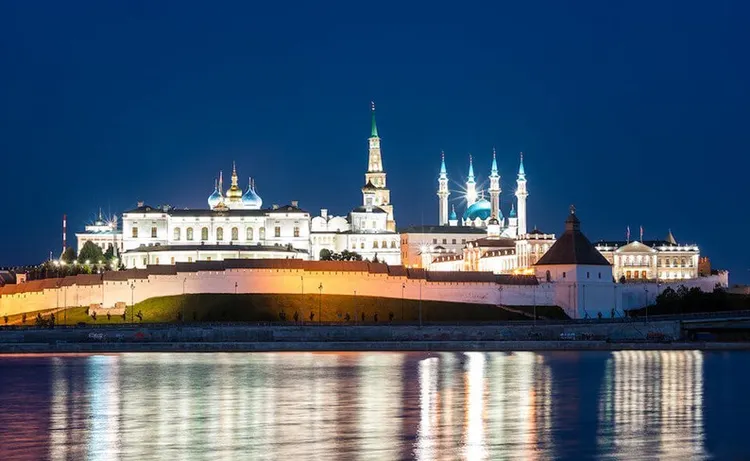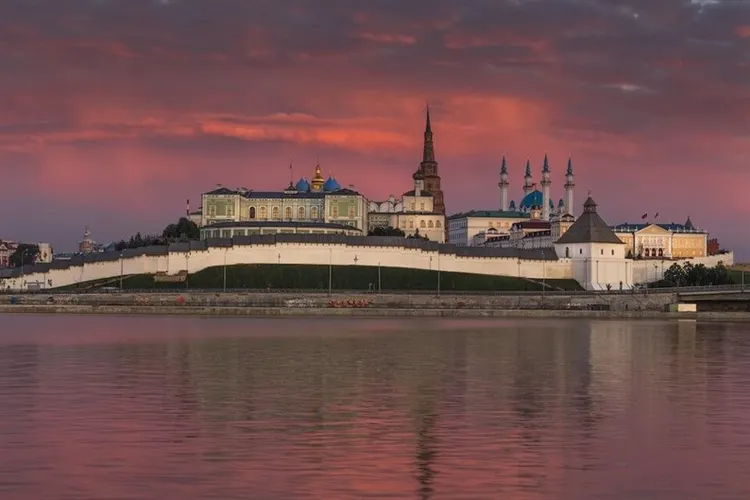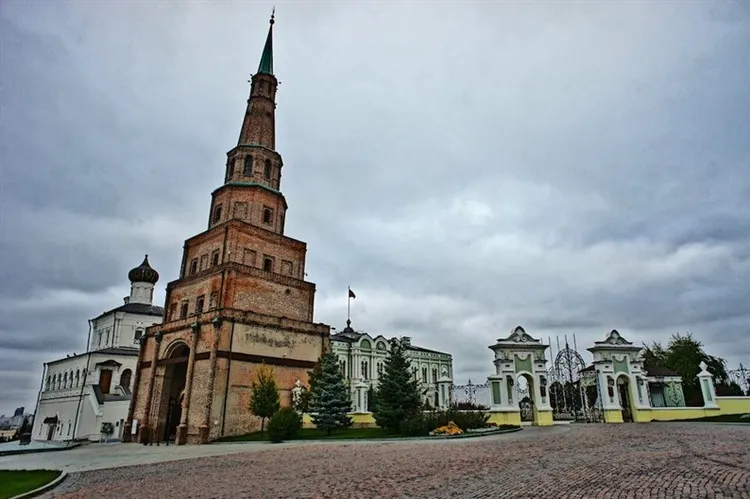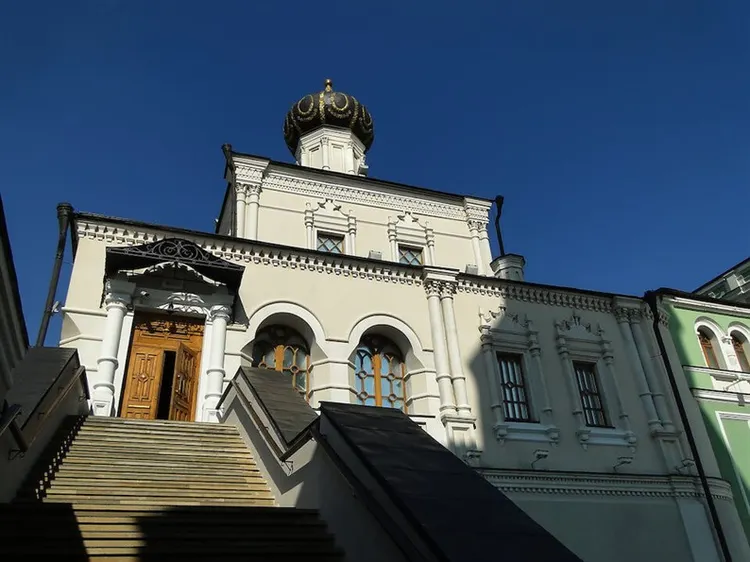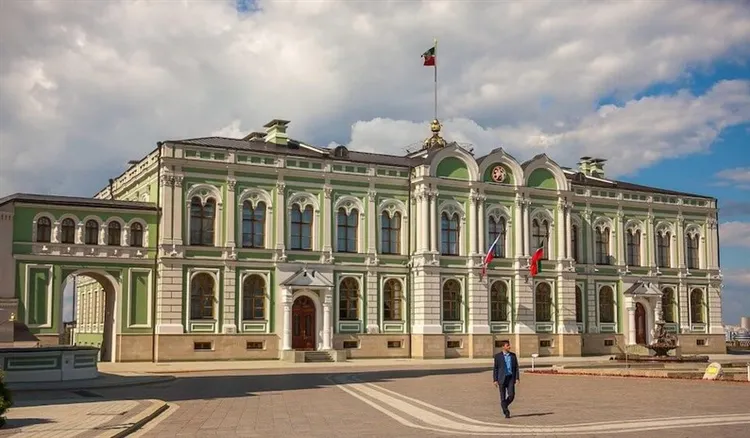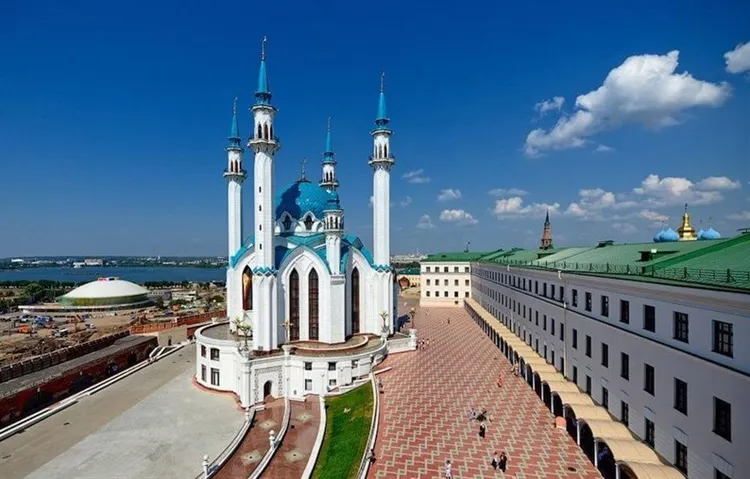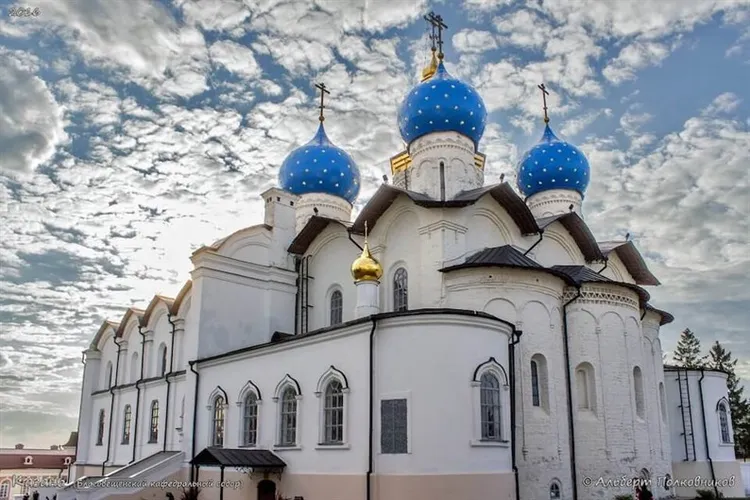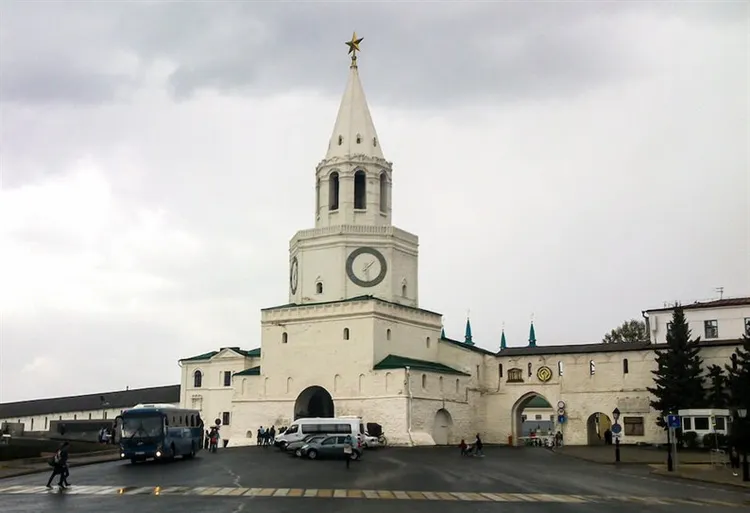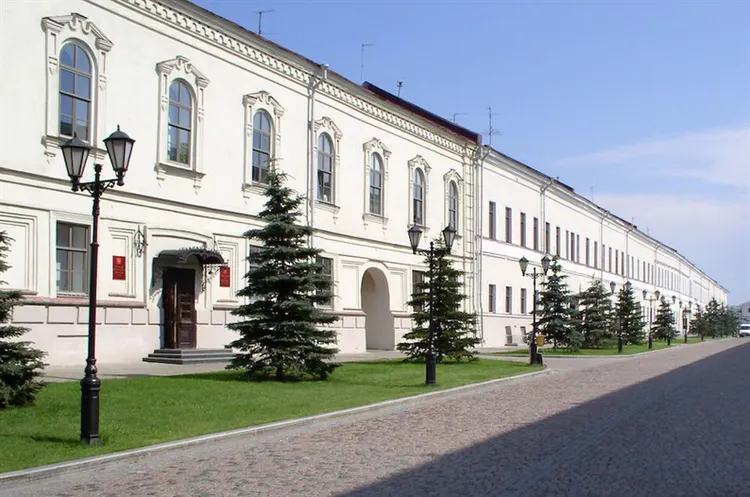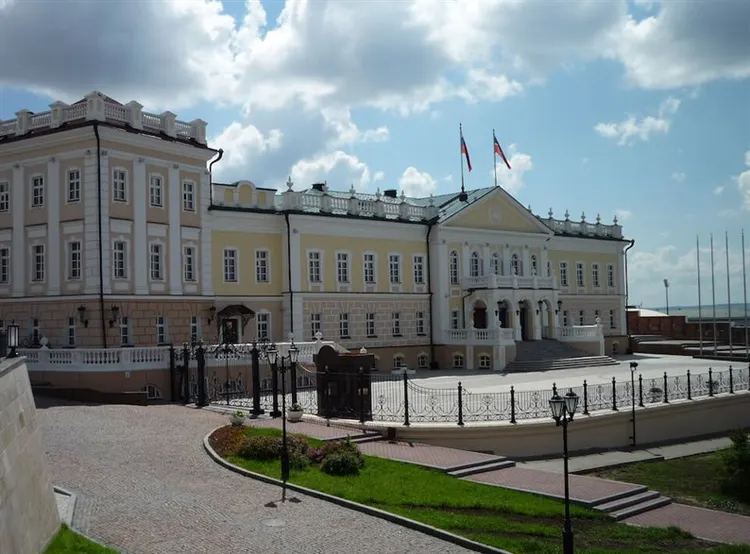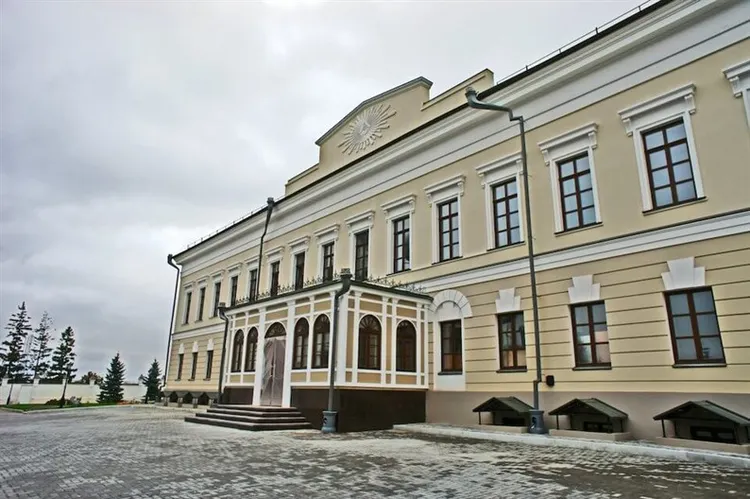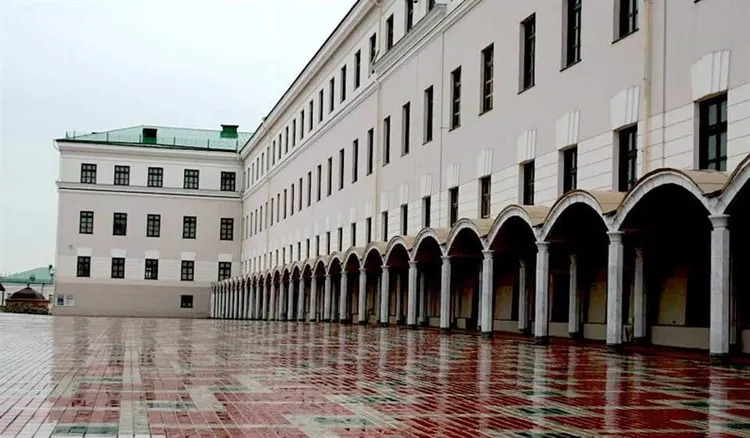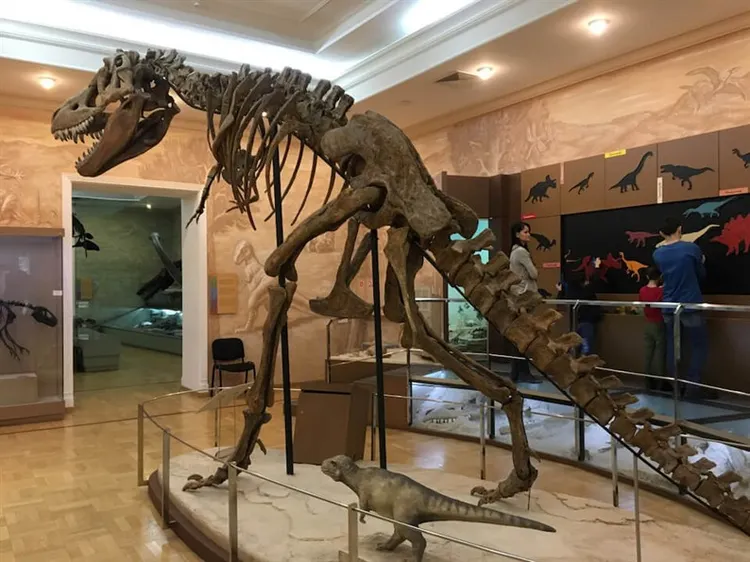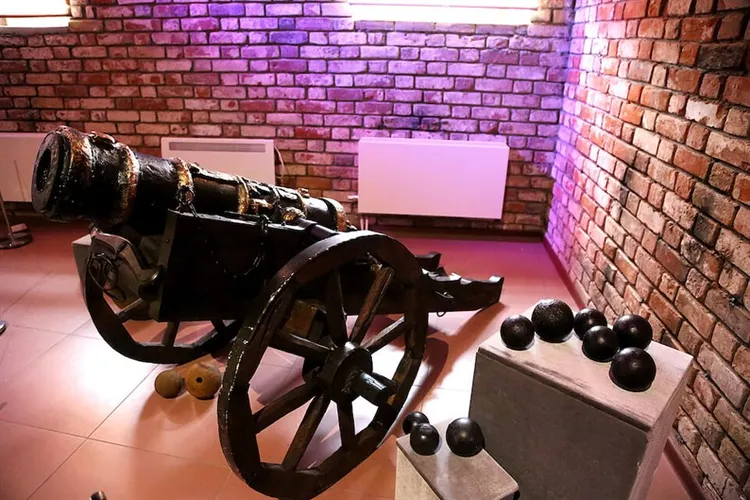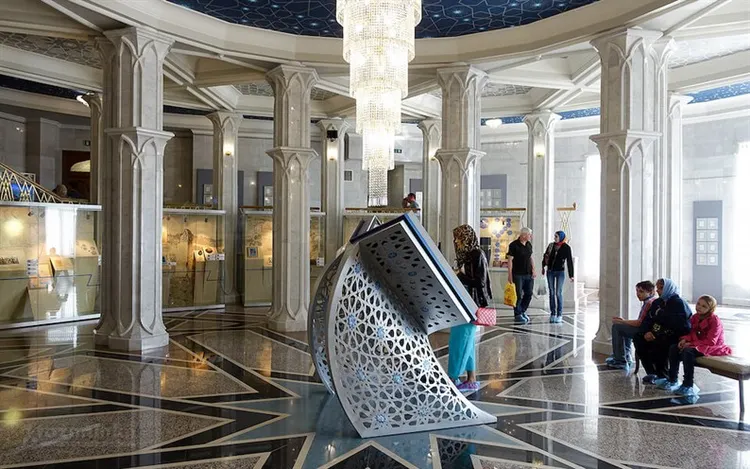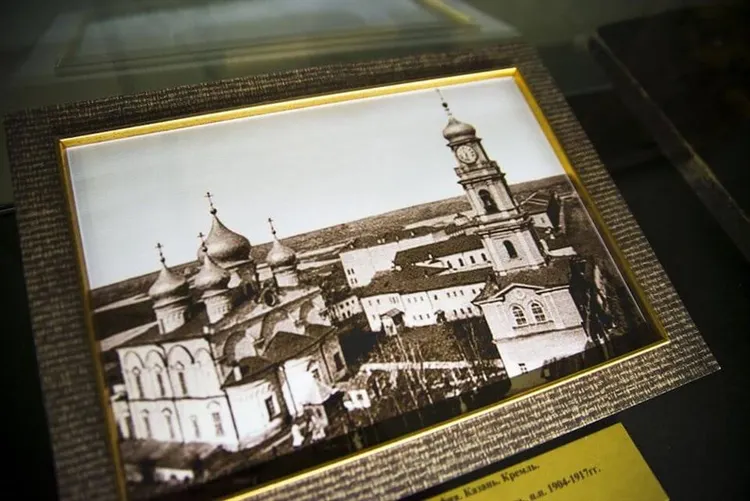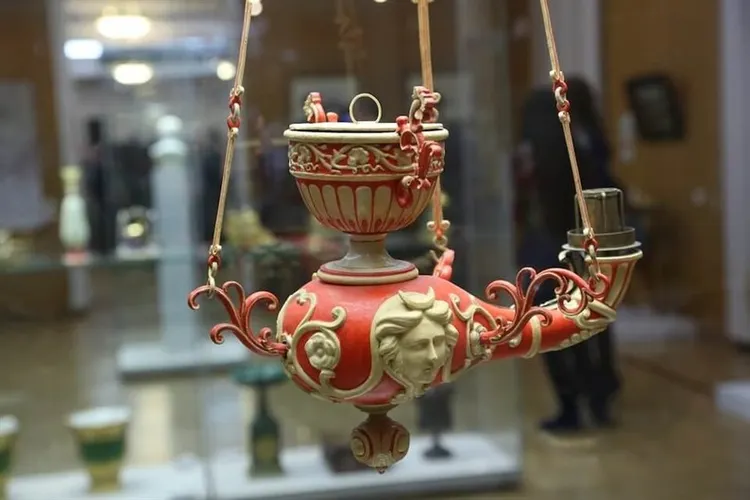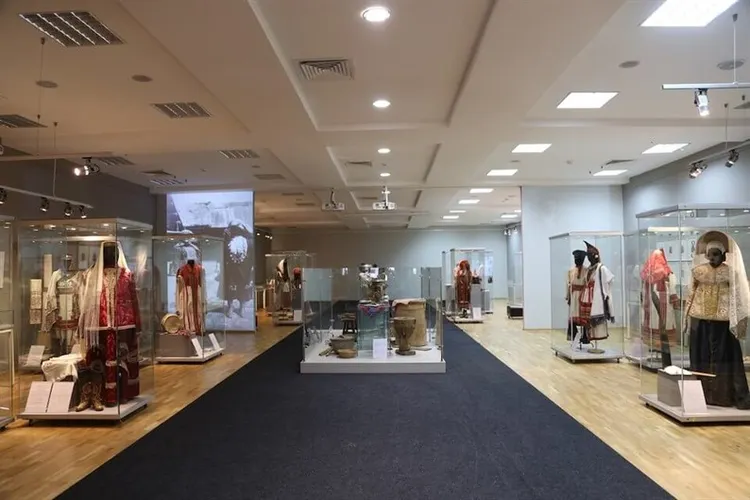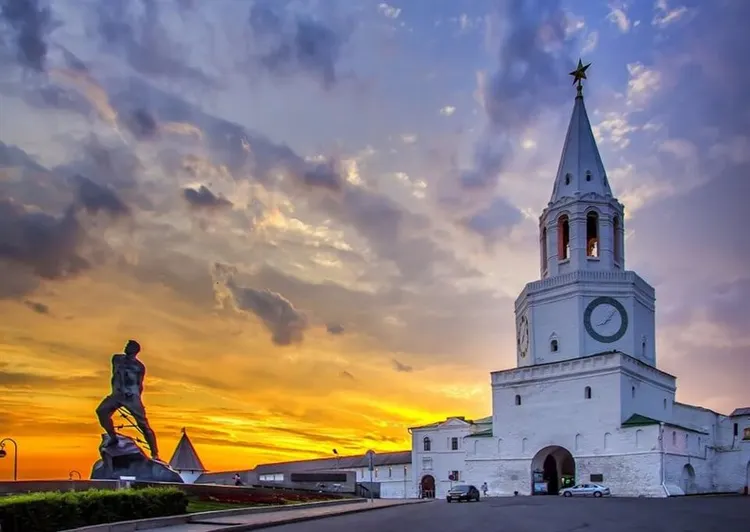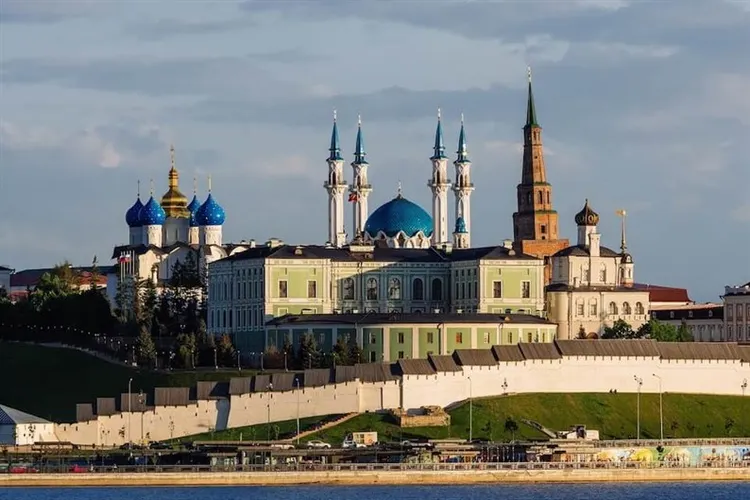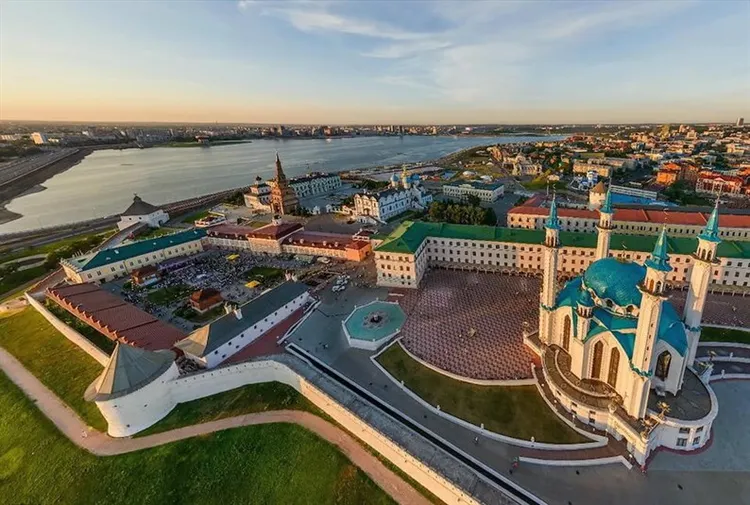The Kazan Kremlin is a unique architectural and historical ensemble. None of the tourists remain indifferent to its unusual beauties: Islam and Orthodoxy, military and peaceful buildings coexist here in a bizarre way. The nature of the building allows us to imagine how the territory of the Kazan Khanate was annexed to Muscovite Russia. Based on the history of buildings over 5 centuries, one can also judge how the new part of the state developed. The Government of Tatarstan pays attention to the preservation of the historical appearance of the ensemble. Despite the fact that restoration work is being carried out on the territory, it is pleasant to walk around the Kremlin: there are information signs on the tourist routes, it is impossible to get lost.
Story
Conventionally, the history of the Kazan Kremlin can be divided into periods:
In 2000, the Kazan Kremlin was included in the list of UNESCO sites. There is a corresponding sign above the entrance gate.
Architecture
After the fall of Kazan in 1552, all the mosques, palaces and auxiliary premises of the Kremlin were destroyed by order of Ivan the Terrible. But he immediately gave a second order: to rebuild the Kremlin in order to use the fortress as a fortification. Pskov architects Postnik Yakovlev and Ivan Shiryai were ordered to work. Under their leadership, the earthen walls were replaced with stone ones, loopholes were cut. Temples were built on the territory in accordance with the traditions of the Pskov school.
In the 17th century, the walls acquired characteristic features: dovetails, narrowed loopholes. At this time, the Kazan Kremlin in architecture began to resemble the Moscow one; as a military object, it was absolutely impregnable. The 18th century brought changes to the political life of the province. The Kremlin ceased to be of interest to the authorities as a fortification object, but formed as the center of Russian Orthodox culture. The restoration of the burnt temples continues. Today's Kazan Kremlin is a symbiosis of Tatar and Russian (Pskov) architectural schools. It is noteworthy that they do not suppress, but harmoniously complement each other.
sights
Some sights of the Kremlin have been restored (Kul-Sharif Mosque). But this makes them even more beautiful and significant: the people appreciate and remember their history. Others were rebuilt at different times. And according to these milestones, you can study how the region developed. Viewing the Kremlin is not only pleasing to the eye, but also enriches the personality.
Tower Syuyumbike
Residents of Kazan are very fond of telling this poetic story to the guests of the city. The seven-tiered tower really exists and is located on the territory of the Kremlin. This structure belongs to the type of falling towers: it has a noticeable slope. And to make it interesting for tourists, they retell a beautiful legend. Ivan, then still just a Moscow prince, heard about the beauty of the ruler of the Kazan Khanate – Syumbika. He sent matchmakers to her, offering to become his wife, promising to put all the riches of Russia at her royal feet. But the proud widow refused.
It was because of this refusal that the Moscow prince went on a campaign against Kazan. He laid siege to the city and threatened to destroy all the inhabitants, destroy all houses and mosques if Syuyumbike refused to become his wife. Syuyumbike is forced to agree, but she sets a seemingly impossible condition for Ivan Vasilyevich: to build the highest tower in a week. The groom accepts this condition, and his capabilities allow him to erect a structure in seven days. At the same time, one day was spent on one tier.
Syuyumbike sadly sat at the wedding feast. She did not want to leave Kazan. The queen asked her husband for permission to climb to the very top of the tower, for the last time to look at the city. Standing on the last tier, she waved her hands and … Then there are two endings to choose from:
In fact, a year before the last assault on Kazan, Syuyumbike married Kasimov Khan Shah-Ali. She lived with him until her death, this is confirmed by the scribe books of the city of Kasimov. And she never met Ivan Vasilievich, although, perhaps, he knew about her beauty and kindness. Now tourists are not allowed inside the tower. But you can always inspect the building from the outside, listen to the legend.
Palace (Vvedenskaya) Church
After the successful assault on Kazan, Ivan the Terrible took all measures to hold the conquered territories. Since 1552, the city was ruled by an Orthodox governor, then the position changed. The affairs of the region were handled by the governor. At the same time, the forcible assertion of Orthodoxy began on the territory of the former khanate. Churches were built instead of destroyed mosques. And on the site of the Vvedenskaya Church there used to be a mosque of Khan Nurgali.
It was not possible to establish the exact date of construction, but it is indicated on the plans of the Kremlin in 1665. It was a house church, the governor, members of his family and the squad prayed in it. The service was conducted by a priest, and the psalmists were invited. After a fire in 1815, gunpowder was stored in the surviving cellars. Later (in the 19th century) the temple was rebuilt: it began to have 3 limits. She again sent home church for the governor and his family. The temple was consecrated in honor of the Descent of the Holy Spirit.
After the October Revolution, the church went through hard times:
The Decree of the President of Russia on the return of nationalized property to the Russian Orthodox Church affected the life of the church. It was restored, but the Church was not returned. Now it is occupied by the Museum of the History of the Statehood of the Tatar People. The building itself is interesting for tourists: it is a perfectly preserved example of early Russian baroque.
Presidential palace
Until 1552, the Khan's palace was located on this site. It included many structures:
The palace was destroyed after the capture of Kazan, but some of the buildings survived. In the 18th century, the chief commandant's house was built on the site of the Khan's palace. But in 1848, it became necessary to build a more spacious and modern building. The project of the architect Ton was taken as a basis. It is not surprising that the building resembles the Grand Palace of the Moscow Kremlin: it was also built by Ton.
The remains of the buildings of the Khan's palace were inscribed in the building. They give the interior originality and sophistication. The palace has always been an official building: first, the governor-general lived in it, then the government of the Tatar Autonomous SSR was located, today it serves as the residence of the President of Tatarstan.
Kul Sharif Mosque
This mosque is a new building. It was built instead of the former Cathedral Mosque destroyed in 1552. 4 assault on Kazan for Ivan of Moscow was successful: the fortress was finally taken. And the last defenders were young shakirds, students of the madrasah at the Cathedral Mosque, led by a mentor – imam seid Kul-Sharif. Before the last battle, the fortress did not have a drop of water: the source was destroyed, but no one surrendered, everyone died. The courage of the 14-year-old boys and the elderly mullah shocked the governor of the Grand Duke.
It is not enough to defeat the enemy, it is also necessary to keep the occupied territory. Ivan the Terrible understood this very well. That is why the mosques of Kazan were destroyed, the practice of Islam was forbidden, and the Pale of Settlement was defined for the inhabitants. The cathedral mosque of the Kremlin was the first to die. Over time, the political situation in the east of Russia has changed. In the 18th century, Catherine the Great visited Kazan, was satisfied with the warm welcome of the Tatars and wished to fulfill their requests. Naturally, the first of the three is to allow open practice of Islam.
But then there could be no talk of restoring the Cathedral Mosque of the Kremlin. This question first arose in the 1990s. In 1995, the President of Tatarstan signed a decree on the restoration of the mosque, immediately announced a competition for the best project. Who would have thought that the diaries kept by the governor Kurbsky, an ally of Ivan the Terrible, would help architects! Of course, he could not know the names of certain parts of the structure, but he described the structure in great detail and figuratively before it was destroyed.
The development area was determined at the location of the Junker School and the adjacent parade ground. The work began in 1996 and ended in 2005. They were carried out with private donations (a total of 400 million rubles). The name was determined by itself.
The mosque was named after the last defender of the city (and Islam) – Imam Seid Kul-Sharif. The reconstruction of the mosque is considered a symbol of the revival of the national traditions of Tatarstan. Now services are held in the Cathedral Mosque, but tourists can visit it with a guided tour, get acquainted with the architecture and Muslim painting – shamail. At the same time, it is important to follow the rules so as not to offend the feelings of Muslims.
Blagoveshchensky cathedral
Already in 1552, a small wooden temple was built on the territory of the Kremlin. It was consecrated in honor of the Annunciation of the Most Holy Theotokos. The temple became a cathedral. Gury (Rugotin) was appointed the first archbishop of Kazan. But after 3 years, a huge diocese was formed, which extended to the eastern borders and included Siberia. A new, more spacious cathedral was needed. Therefore, a new building began to be built on the site of the old church.
The material was found not far away: on the opposite bank of the Volga there were deposits of white limestone. And Ivan the Terrible ordered the masters to be delivered from Pskov. 80 masons arrived for the construction, and Postnik Yakovlev and Ivan Shiryai were in charge of everything. The temple turned out to be the southernmost monument of Pskov architecture. In 1562, construction was completed, Gury consecrated the new cathedral.
Despite the stone building, the temple burned several times. The fire on September 3, 1815 was especially devastating. The entire archive of the Kazan province, which was kept in the cathedral, perished. The building was not restored for two years. In 1841, the restoration ended with the construction of the bishop's house. The archbishop moved closer to the cathedral.
During the October coup, the temple was badly damaged: the Red Army did not really care about the safety of the cathedral, they hit the domes with direct fire. All heads were destroyed. But the misadventures of the temple did not end there: it was first closed, then handed over to the renovationists, then closed again. The valuables were looted, many lost. After some time, an order was received to dismantle the porch into bricks, to remove the doors. The temple itself miraculously survived.
In the 1970s and 1980s, the building was restored. From the original architecture there are pillars connected by arches, the central volume, side aisles, part of the frescoes. Now the cathedral has been returned to the Russian Orthodox Church. Archbishop Anastassy of Kazan consecrated it in 2005. Tourists can see the temple from the outside, admire the monument of Pskov architecture, serve and visit the cell of Gury Kazansky, pray before the image of the Savior Not Made by Hands of the 16th century.
Spaso-Preobrazhensky Monastery
The territory of the former Kazan Khanate was settled by the Orthodox. This was the policy of Ivan the Terrible to develop rich lands. But without monasteries (male and female), it would be impossible to carry out all the activities: in the 16th century they were the center of culture and, to a large extent, contributed to the unity of the Russian people. After the fall of Kazan in 1552, the Kremlin remained the administrative and cultural center. It is not surprising that the Spaso-Preobrazhensky Monastery was founded on its territory. Its task was to become a stronghold of Orthodoxy in the region.
Archimandrite Barsanuphius was appointed for the organization. In his youth, he spent several years in Tatar captivity, knew the language and customs of Muslims. And in 1556 construction began. The monastery was located on a tiny territory: less than 1 hectare. It was impossible to expand it: on two sides it was closed by the remains of a fortress wall, and on the third – by a fence, which later reached the temple of Cyprian and Justinia, which was later attached to the monastery.
Very soon, the Spaso-Preobrazhensky Monastery began to play an important role in the life of the Orthodox Volga region. It was visited by pilgrims, but in terms of wealth and significance it was surpassed by the Assumption Monastery, located in the city of Sviyazhsk. Nevertheless, when Catherine the Great in 1764 demanded that class ranks be assigned to the monasteries, Uspensky received the first, and Spaso-Preobrazhensky – the second. And in the whole empire, only 59 monasteries received the second class. Famous Orthodox residents of Kazan were honored to be buried on the graveyard of the monastery: scientists, priests, merchants. Archbishop Gury, the city's high priest, was buried there first.
The monastery had revered shrines:
After the October Revolution, a military town was founded on the territory. The monks Benedict and Varsonofy, together with the nuns of the Bogoroditsky Monastery, saved some of the shrines. In subsequent years, the architectural ensemble was almost completely destroyed. Today, a tourist can admire the restored Fraternal building, see the basement of the Transfiguration Cathedral and the basement of the white stone church of St. Nicholas the Warrior.
Office building
Architect Kaftyrev V.I. began work on the project in 1767. He set a goal: to build a building in which official receptions would be held, where the governor and his assistants would operate. The first floor of the building was intended for the work of presences, the second – for balls and audiences. Pavel I visited Kazan in 1798, and a ball was held in his honor in the Provincial Chancellery. The emperor was struck by the rich decoration of the hall, the acoustics of the room. For the first time in the life of the province, not only Orthodox citizens, but also Muslim clergy, and Tatar merchants with their families were invited to a social event.
The building was replanned and rebuilt in the 20th century. Until 2017, the following people worked in the building:
In May 2017, the authorities restored the former appearance of the office. It turned out that, in addition to parsing the partitions, it is required to strengthen the foundation. When the work is completed, the premises will be given over to the Museum of the History of the Statehood of the Tatar People and the Republic of Tatarstan.
Consistory building
It is impossible to manage the affairs of the huge Kazan diocese without a consistory. The device was created in 1739. And for its functioning, it is necessary to build a building where officials from the church would be located. In the consistory, they decided who should be excommunicated and for how many years, considered petitions for divorce, and imposed penalties on blasphemers. Priests and class officials worked side by side. The power of the consistory was stronger than that of an individual bishop.
The historical significance of the Kazan Consistory was fixed in verse by the future writer A.M. Bitter. Here he (then Alexei Peshkov) was excommunicated for 7 years for attempting suicide. The original building was completely destroyed by a fire in 1815. And the one that tourists see today was created on the basis of the stable yard of the bishop in 1815. Tourists can see the consistory from the outside, but they won't be able to get inside: the Institute of History of the Academy of Sciences of the Republic of Tatarstan is located there.
bishop's house
Near the Cathedral of the Annunciation was the house of the bishop. Gury was the first priest who lodged there. The building was built of wood, but at the beginning of the 17th century it was rebuilt in stone. The house fell into disrepair, in the middle of the 18th century it became dangerous to live in it, and Metropolitan Veniamin moved out of town. In 1815 the building was completely destroyed by fire. The bishop had to travel to the service.
At the personal expense of Nicholas I in 1829, a palace of 2 floors was built on the site of a burnt house. The building was a church, from 1909 until the October Revolution – a shelter for boys. In the 20th century, another floor was built on, but in the 21st century, the former appearance was restored. The Bishop's Palace represents the architecture of late classicism. Institutions are located inside, so the building can be viewed from the outside.
Junker School
The building was designed by the architect Pyatnitsky in 1840. Initially, it was used as a barracks for cantonists. But already in September 1866, the building was transferred to the cadet school. At first, 200 cadets were trained, then the staff increased to 400. In 1909, the cadet school was transformed into a military one.
Graduated in different years:
The building is a sample of the official Pavlovian Empire style. Now it houses museums and the Khazine Gallery.
Guardhouse building
In the 16th century, this place was the home of the voivode and the services of the sovereign. But in the 19th century, a guardhouse building was required. The 3-storey building is made of plastered brick, has an L-shaped profile, a gable roof. There are no facade decorations. In 1998, a large-scale restoration was carried out.
Museums
The Kazan Kremlin is a place where various museums await visitors. Tourists can get acquainted with permanent and temporary exhibitions, participate in master classes, and even organize their own holiday. Almost all halls have interactive screens that help to better explore the exhibitions. Announcements of events will allow you to determine the age of visitors: some expositions are designed only for adult tourists, others will be of interest to children as well.
Museum of Natural History of Tatarstan
This new research and education center welcomed its first visitors in 2005. The unique exposition became interesting for children and adults.
The first floor represents the history of mineralogy and astronomy. Tourists are offered:
On the second floor there is a unique paleontological exposition. Visitors will see a slab with prints left by a parareptile 225 million years ago. Of particular interest are the mammoth and tarbosaurus. In addition to regular tours, the museum holds one-time thematic events designed for a specific age of visitors.
Museum of the History of Statehood of Tatarstan
The Museum of the History of the Statehood of the Tatar People and the Republic of Tatarstan is located in the heart of the Kazan Kremlin. It presents exhibitions dedicated to:
It is noteworthy that the museum widely uses progressive computer technologies. Films illustrating the events of the life of the Tatar people are broadcast on the big screen.
Cannon Yard Museum
In the 16th and 17th centuries, Kazan became the most important outpost of Russia in the east. But it was long and expensive to transport weapons, so at the end of the 17th century, by the sovereign's decree, the Cannon Yard was formed on the territory of the Kazan Kremlin. At first, there was a pit for casting cannons, nearby – officers' apartments, later – a soldier's canteen.
After a complete restoration, which ended in 2014, visitors have the opportunity to get acquainted with the permanent and temporary exhibitions. Tourists get acquainted with the history of Russian weapons. Interior interiors contribute to complete immersion in history. Lectures and expositions are held on the premises of the Cannon Yard Museum, even fashion designers present new collections.
Museum of Islamic Culture
This is the only museum in Russia that tells about Islam and Muslim culture. It is located in the basement of the Kul Sharif Mosque. The museum was opened recently, in 2006.
The purpose of the museum:
In 2014, the museum fund was replenished with new unique exhibits.
Museum of the History of the Annunciation Cathedral
Few Orthodox cathedrals have museum expositions. The Museum of the History of the Annunciation Cathedral describes a vast layer of history: from 1552 to the last days. The exposition presents more than a hundred items, among them:
Visitors are invited to immerse themselves in history with the help of interactive technologies. A film about the icon of the Kazan Mother of God “Intercessor” is shown on the screen.
Hermitage-Kazan Center
This is a unique museum. First, starting in 1997, the St. Petersburg State Hermitage Museum held thematic expositions on the territory of the Kazan Kremlin. Since 2005, the Hermitage-Kazan has been the permanent representative office of the Hermitage in St. Petersburg.
Visitors are offered:
The museum uses interactive technologies that help to better understand the history of Russia and Tatarstan.
Exhibition Hall “Manege”
Junkers were required to be able to ride, so in 1880 the Manege was built to train the military and dressage horses. Now this building is located on the most passable place: visitors to the Kremlin cannot pass by. It is this, and excellent daylight, that determined the purpose of the building: since October 2009, it has been operating as an exhibition hall. The first exhibition is “Russia. XX century in photographs. Today it has become a tradition to hold New Year's and festive programs for children and adults in the Manege. Master classes are often held, among them teaching the art of ebru stands out.
Lost buildings and structures
But not all historical buildings of the Kazan Kremlin have survived to this day. A sad fate awaited:
Tourists can see these monuments only in photographs.
Archaeological research
The Kazan Kremlin is a place of ongoing scientific work:
The last archaeological work was carried out in the 90s of the twentieth century. Scientists have proven that the Cathedral of the Annunciation was not built over the destroyed mosque.
Opening hours and ticket prices
Tourists are invited to visit the Kazan Kremlin at any time of the day. When entering through the Spasskaya Tower, guests enter the territory around the clock. If sightseers wish to enter the reserve through the Tainitskaya Tower, then they can do this:
Visiting the territory of the Kazan Kremlin is free for all categories of citizens. But you will have to spend money on going to museums, on shows and thematic exhibitions. Many museums provide discounted tickets for children, schoolchildren, students, the disabled and pensioners. If a sightseer purchases a single ticket to visit all the Kremlin museums, he will receive a discount on thematic exhibitions and expositions. It costs a single 700 rubles.
Excursions
It is difficult to explore the architectural reserve on your own, especially if the tourist is limited in time. Excursions will help the guest to learn and systematize historical facts and local legends. They are conducted by local historians and scientists who know the complex and are able to tell about it.
Sightseeing tour of Kazan with a visit to the Kremlin
What is the best way to get to know Kazan? Of course, book a sightseeing tour with a visit to the Kremlin! Traveling on a comfortable bus accompanied by a guide will allow tourists to get acquainted with:
But that's not all. Tourists will have an informative walk around the Kremlin with a visit to the main museums. Time will fly by unnoticed, and love for the city will remain in the hearts of tourists forever!
Kazan Kremlin through the centuries
It is unlikely that there is another place in the world where Orthodox and Muslim traditions are so intricately intertwined, where Russian and Tatar cultures coexist so closely. And to learn about how all this happened, what contributed to the fraternal unity of the two peoples, a tour of the amazing museum-reserve will help.
A competent and dedicated guide will tell you how the Kremlin was formed from the 10th century to the present day. Tourists will hear many facts and scientific hypotheses for the first time. During an eventful journey, tourists will visit Orthodox and Muslim shrines, get acquainted with historical facts and beautiful legends. Since you will have to walk a lot, it is recommended to invite children over 16 years old.
Kazan: first meeting
The first meeting with Kazan is the most exciting. The further relations between the tourist and the city depend on how it passes.
Where should you start dating? Of course, with what will leave an unforgettable impression! And this tour will help. The guest is invited to visit:
The guide, a local historian who is passionate about his work, will introduce guests to the most interesting places in Kazan, talk about honorary and famous citizens who lived in the city, and answer all questions. A few hours fly by like a blink of an eye. And after the first meeting, you will want to meet with Kazan again and again!
Where is it located and how to get there
The museum-reserve is easy to find: it is located at the address – 420111, Kazan, the Kremlin. On your own, you can take the metro to the Kremlevskaya station, then take a walk to the entrance. If desired, it is easy to get there by land transport: buses 6, 15, 29, 35, 35a, 37, 47, 74, 74a, 75 will take the guest to the stops “TsUM”, “Central Stadium”, “Palace of Sports”. Tourists who come to the reserve by private car may encounter difficulties with parking.
